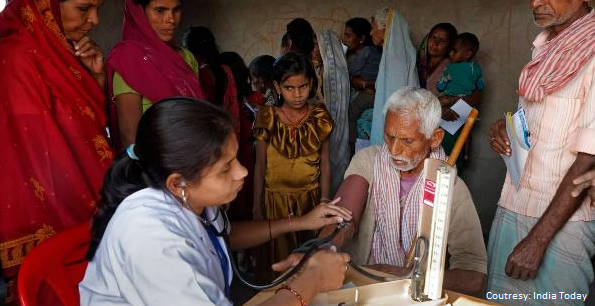
India’s new tryst with government health insurance
31 July 2018
This Budget season, Finance Minister Arun Jaitley committed to launch the ambitious National Health Protection Scheme (NHPS) with thumping applause from the House. The enthusiasm was understandable as out-of-pocket medical expenses make up over half of the total health spending in India. Recognising India’s huge out-of-pocket health spending as catastrophic[1], this scheme has been touted to alleviate the burden of health expenses of the poor by way of insurance.
NHPS forms an essential part of Ayushman Bharat as it aspires to provide secondary and tertiary health care coverage alongwith the revamped Health and Wellness Centres for primary care. Deliberations are currently on as health societies and departments around the country are busy figuring out the design and implementation of this new scheme which shall subsume RSBY and run parallel to other state insurance schemes. NITI Aayog too has created multiple subgroups to deliberate on the feasibility of its design and benefit packages. Keeping the modalities of the scheme aside, there are certain essential questions we need to ask. Firstly, what is India’s current situation with regard to health spending? And secondly, what are our past experiences of government sponsored health insurance schemes?
The extent of spending on private medical care
The Out-of-pocket expenditure (OOPE) by Indian households stands at a whopping 63% of the total health expenditure. Meanwhile, the health expenditure by the government has been a mere 1.13% [2] of the GDP (or 29% of the total health expenditure)[3].
This is primarily because the government’s capacity to provide secondary and tertiary care is still limited in most states. As a result, around 58% of the country’s rural population and 68% of the urban population seek private hospitalised treatment. They foot their medical bills from household income/savings in rural (68%) and urban areas (75%) followed by borrowed money. The figures for the latter are higher for rural (25%) than urban (18%) areas. India’s household health spending has been a major determinant in pushing poor households towards impoverishment[4].
Government spending is low, even within the health expenditure- the Union government contributed only 37%[5]. The centre’s low allocation on health has been explained with its lower tax to GDP ratio, limited fiscal space and changing political priorities in the past. This year the budget for RSBY was increased three-fold to Rs 2,000 crore. It is however unclear whether this budget will cover the target beneficiary number of 10 crore families per year under NHPS.
The realities of implementation
India’s past experiences with government financed health insurance schemes have not been seamless as envisioned. Lower claims to premium ratio have led to the underutilisation of payments made by the government to insurance agencies[6]. If such a trend continues with NHPS, where the risk burden of premium payment is entirely on the government, the benefits expected from the government’s increased expenditure on health will naturally only be marginal. With the new National Health Policy seeking to bring in private partners to fill in critical gaps in healthcare, there is yet to be clarity on the engagement between government and private insurance agencies for NHPS.
Also, beneficiaries seem to be lukewarm to the idea of health insurance coverage. 29% of Indian households have only 1 member covered under any health insurance scheme. The figures look grim seeing the differences among states – with 75% of households in Andhra Pradesh insured compared to only 4% in Manipur. Interestingly, there isn’t much difference between rural and urban areas in terms of insurance coverage. In 2014, 86% of the rural and 82% of the urban population were still un-insured with 91% of the bottom 20% quintile class of urban areas out of coverage[7]. The possible explanation for this exclusion could be the urban population enrolled under RSBY faced a higher price as compared to its rural counterparts with no marked difference in inpatient expenditure[8].
Operational inefficiencies such as delays in payment to empanelled hospitals, staff shortages, lack of autonomous fund managers, weak management information systems and lack of procedural knowledge of the insured will only add up to the challenges of reducing out of pocket expenditure of rural households.
As it has been announced to be an expansion of the already existing RSBY, it is likely to be designed as a government sponsored health insurance scheme with/without a token contribution from beneficiaries. This financing approach for India is a deviation from the general trend of lower middle income nations towards healthcare. Most developing nations either leave insurance on OOPE, risk pooling among formal sector employees or take a social health insurance approach where both the government and formal sector pool the risks and cover the poor[9]. Though each country varies in regard to its organisation of public and private providers, payment systems, regulation and disease burden, India taking the burden on itself should therefore make sure this scheme is more effective.
As any other newly rolled out large scale programme, NHPS too will take time to figure what works and what doesn’t to reduce OOPE. Going forward we should take into account the plethora of past experiences and focus on its financing model and sustainability, variation across states in terms of disease burden, rural-urban differences and the possible operational lacuna. Certain states such as Andhra and Tamil Nadu are already running successful insurance schemes which could offer possible direction for NHPS.
[1] Catastrophic health expenditure occurs when out-of-pocket (OOP) payments for health services consume such a large portion of a household’s available income and the household may be pushed into poverty as a result.
[2] National Health Profile 2018 records it at 1.28% of GDP as of 2017-18 BE.
[3] THE- Total Health Expenditure includes both current and capital expenditure.
[4] Fu, 1999
[5] NHA 2014
[6] NIPFP report
[7] NSSO 2014 on Health
[8] Jayakrishnan et al, Pharmacoeconomics, 2016
[9] Hsiao and Shaw, SHI for Developing Nations, The World Bank, 2007





